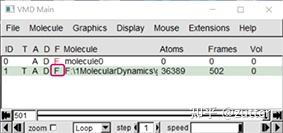
The MDFF graphical user interface (GUI) in the Modeling section of the VMD Extensions menu has been updated to reflect the use of multiple maps in addition to many other usability improvements. The MDFF setup plugin now supports the use of multiple density maps in a single MDFF simulation.

A new tool has been added to the BuildPar toolset that processes output from the CGenFF Program webserver to automatically construct all of the structural and parameter input required for entry into the ffTK parameterization workflow, bypassing a common stumbling block in structure preparation.Two new major features have been added to the Force Field Toolkit for the VMD 1.9.3 release. The Force Field Toolkit (ffTK) plugin provides a comprehensive toolset for the development of CHARMM-compatible (e.g., CGenFF) force field parameters, including charges, bonds, angles, and dihedrals.QwikMD incorporates logging of procedures for reproducibility, and to enable simulation workflows and protocols to be shared among users. For more information, the user is redirected to web-pages through links present in the bottom of the information window. Each "info button" generates a window where the user can find fundamental information related to Molecular Dynamics simulations, such as the description of solvent models and protein structure, as well as short explanations of the options available in QwikMD graphical interface and the actions triggered by the buttons. While making it easy for a new user to perform simulations, QwikMD also works as a learning tool with "info buttons" that guide the user and provide the theoretical background underlying the procedures that are followed. Connecting the user-friendly molecular graphics program VMD to the widely adopted MD program NAMD, the new QwikMD plugin guides users to prepare common molecular simulations in just a few minutes, allowing for quickly study of point mutations, partial deletions or even steering experiments.

Now open up the terminal and go to the directory, where the images from the movie maker are saved. You can either write the path to a folder in either “Selection” or manually select the path to that folder using your mouse.

Also, to change the location of a folder that will have and save all the JPEG pictures, press on “Set working directory:” button which is shown below.

Lastly, make sure to put a title on your movie in a box on next to “Name of movie”. This will take take many spanshots of your movie amd save with a “.jpeg” extension. The last button that you should press is “Format” and select “JPEG frames(ImageMagick)”. Next press on the “Movie Setting” and select “Trajectory”, these steps are shown below: In that window, press on the “Renderer” button and select “Internal Tachyon(Ray Tracer)” from the dropdown menu. Those steps should take you to a window called “VMD Movie Generator” shown below. This following image shows the steps you chose: After loading your files to VMD, press on a Window called VMD Main and press on Extension menu and select “Visualization”, and “Movie Maker” from the dropdown menu.


 0 kommentar(er)
0 kommentar(er)
